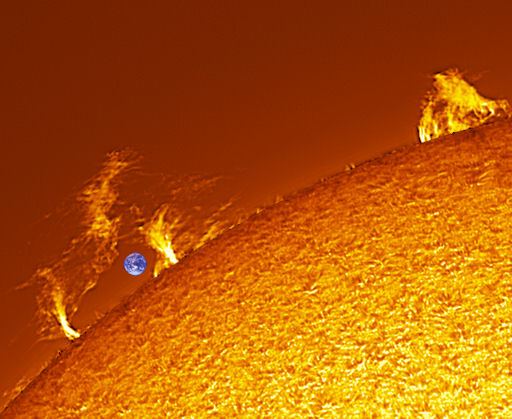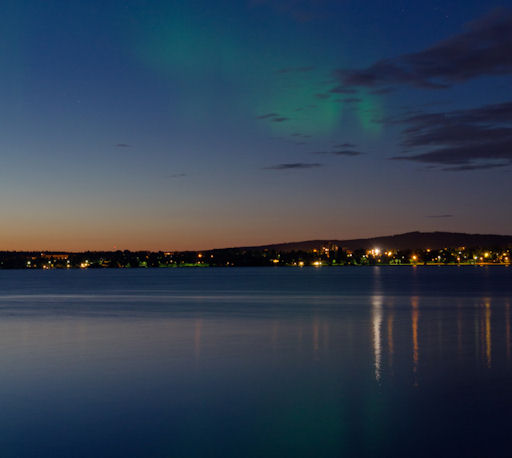Metallic photos of the sun by renowned photographer Greg Piepol bring together the best of art and science. Buy one or a whole set. They make a stellar gift. | | |
SPACE STATION METEOR: On August 13th during the peak of the Perseid meteor shower, ISS astronaut Ron Garan photoraphed a spectacular fireball from Earth orbit. Researchers at the NASA Meteoroid Environment Office are analysing the photo to confirm that the meteor was indeed a Perseid. Stay tuned for updates.
SOLAR ACTIVITY: After a few days of quiet, the sun is coming alive again. Amateur astronomers around the world report a beautiful complex of prominences dancing along the eastern limb, one of them big enough to swallow Earth:

Good news: The blue dot is merely a digital image of Earth inserted by photographer Jesús Carmona de Argila of Madrid, Spain, for scale. The prominence is a comfortable 93 million miles from our planet.
In addition to these prominences, a large sunspot group is emerging over the eastern limb. Readers with solar telescopes are encouraged to monitor the area for developments.
SUMMER AURORAS: A minor solar wind stream hit Earth's magnetic field during the early hours of August 15th, sparking auroras around the Arctic Circle. If the impact had occured just a few weeks ago, the midnight sun would have wiped out any Northern Lights, but now August nights are darkening enough to see geomagnetic activity. Göran Strand sends this picture from Frösön, Sweden:

"I was out photographing the moon when suddenly an aurora appeared," says Strand. "It lasted for about two minutes and it was quite big."
Arctic sky watchers should be alert for more summer auroras tonight. NOAA forecasters estimate a 35% chance of high-latitude geomagnetic activity as the solar wind continues to blow.
August 2011 Aurora Gallery
[previous Augusts: 2010, 2009, 2008, 2007, 2006, 2005, 2004, 2003, 2002]
2011 Noctilucent Cloud Gallery
[previous years: 2003, 2004, 2005, 2006, 2007, 2008, 2009]
Potentially Hazardous Asteroids (
PHAs) are space rocks larger than approximately 100m that can come closer to Earth than 0.05 AU. None of the known PHAs is on a collision course with our planet, although astronomers are finding
new ones all the time.
On August 15, 2011 there were 1241 potentially hazardous asteroids.
Notes: LD means "Lunar Distance." 1 LD = 384,401 km, the distance between Earth and the Moon. 1 LD also equals 0.00256 AU. MAG is the visual magnitude of the asteroid on the date of closest approach. | | The official U.S. government space weather bureau |
| | The first place to look for information about sundogs, pillars, rainbows and related phenomena. |
| | Researchers call it a "Hubble for the sun." SDO is the most advanced solar observatory ever. |
| | 3D views of the sun from NASA's Solar and Terrestrial Relations Observatory |
| | Realtime and archival images of the Sun from SOHO. |
| | from the NOAA Space Environment Center |
| | the underlying science of space weather |
| | for out-of-this-world printing and graphics |

